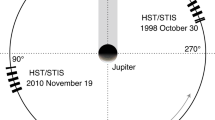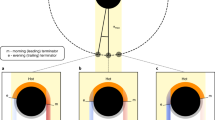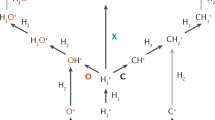Abstract
Mass spectrometer composition measurements of stratospheric negative ions were first made by Arnold and Henschen1 using a balloon-borne instrument. These initial measurements, which were taken at an altitude of 36.5 km, revealed that the major ion species are NO−3(HNO3)a and HSO−4(H2SO4)b(HNO3)c. The suggestion that the unexpected HSO−4 cores are formed from NO−3 cores by a reaction involving stratospheric sulphuric acid vapour1 was strongly supported by laboratory measurements of the relevant ion-molecule reactions by Viggiano and colleagues2. Meanwhile, major instrumental refinements in balloon-borne ion mass spectrometers, including increased mass range, sensitivity and mass resolution, have resulted in the detection of more massive HSO−4(H2SO4)b ions and in the extension of the height range from a thin layer around 35 km to a region extending from 23 to 39 km (refs 3,4). Here we report in situ negative ion composition measurements of even higher sensitivity which led to the detection of previously unobserved ion species.
This is a preview of subscription content, access via your institution
Access options
Subscribe to this journal
Receive 51 print issues and online access
$199.00 per year
only $3.90 per issue
Buy this article
- Purchase on Springer Link
- Instant access to full article PDF
Prices may be subject to local taxes which are calculated during checkout
Similar content being viewed by others
References
Arnold, F. & Henschen, G. Nature 257, 521–522 (1978).
Viggiano, A. A., Perry, R. A., Albritton, D. L., Ferguson, E. E. & Fehsenfeld, F. C. J. geophys. Res. 85, 4551–4555 (1980).
Viggiano, A. A. & Arnold, F. Geophys. Res. Lett. (in the press); Planet Space Sci. (in the press).
Arijs, E., Nevejans, D., Frederick, P. & Ingels, J. Geophys. Res. Lett. (in the press).
Arnold, F., Böhringer, H. & Henschen, G. J. geophys. Lett. 5, 653–656 (1978).
Arnold, F., Henschen, G. & Ferguson, E. E. Planet. Space Sci. 29, 185–193 (1981).
Arnold, F., Fabian, R., Ferguson, E. E. & Joos, W. Planet. Space Sci. 29, 195–203 (1981).
U.S. Standard Atmosphere Suppl. (U.S. Government Printing Office, Washington DC, 1966).
Henschen, G. & Arnold, F. Nature 291, 211–213 (1981).
Kebarle, P. A. Rev. phys. Chem. 28, 445–476 (1977).
Yamdagni, R. & Kebarle, P. J. Am. chem. Soc. 93, 7139–7143 (1971).
Payzant, J. D., Yamdagni, R. & Kebarle, P. Can. J. Chem. 49, 3308–3314 (1971).
Janousek, B. K. & Brauman, J. I. in Gas Phase Ion Chemistry Vol. 2 (ed. Bowers, M. T.) Ch. 10 (Academic, New York, 1979).
Fehsenfeld, F. C., Howard, C. J. & Schmeltekopf, A. L. J. chem. Phys. 63, 2835–2841 (1975).
Stull, D. R. & Prophet, H. (eds) JANAF Thermodynamical Tables 37 (National Standards Reference Data Series, U.S. National Bureau of Standards, 1971).
Ferguson, E. E., Fehsenfeld, F. C. & Albritton, D. L. in Gas Phase Ion Chemistry Vol. 1 (ed. Bowers, M. T.) Ch. 2 (Academic, New York, 1979).
Coffey, M. T., Mankin, W. G. & Cicerone, R. J. Science (submitted).
Rosenstock, H. M., Draxl, K., Steiner, B. W. & Herron, J. T., J. phys. chem. Ref. Data 6 (1977).
Fehsenfeld, F. C. & Ferguson, E. E. J. chem. Phys. 61, 3181–31393 (1974).
Elsaesser, H. W., Harries, J. E., Kley, D. & Penndorf, R. Planet. Space Sci. 28, 827–835 (1980).
Ackerman, M. J. atmos. terr. Phys. 41, 723–733 (1979).
Prasad, S. S., Jaffe, R. L., Whitten, R. C. & Turco, R. P. Planet. Space Sci. 26, 1017–1026 (1976).
Glasgow, L. C., Jesson, J. P., Filkin, D. L. & Miller, C. Planet. Space Sci. 27, 1047–1054 (1979).
Molina, M. J., Ishiwata, T. & Molina, L. T. J. phys. Chem. 84, 821–826 (1980).
Platt, U., Perner, D., Harris, G. W., Winer, A. M. & Pitts, J. N. Jr Nature 285, 312–314 (1980).
Arnold, F., Fabian, R., Henschen, G. & Joos, W. Planet. Space Sci. 28, 681–685 (1980).
Davidson, J. A., Fehsenfeld, F. C. & Howard, C. J. Int. J. mass Spectrom. Ion Phys. 9, 17–29 (1977).
Lee, N., Keesee, R. G. & Castleman, A. W. Jr J. chem. Phys. 72, 1089–1094 (1980).
Wlodek, S., Luczynski, Z. & Wincel, H. Int. J. mass Spectrom. Ion Phys. 35, 39–46 (1980).
Author information
Authors and Affiliations
Rights and permissions
About this article
Cite this article
McCrumb, J., Arnold, F. High-sensitivity detection of negative ions in the stratosphere. Nature 294, 136–139 (1981). https://doi.org/10.1038/294136a0
Received:
Accepted:
Issue Date:
DOI: https://doi.org/10.1038/294136a0
This article is cited by
-
Development of a novel surface assisted volume negative hydrogen ion source
Scientific Reports (2017)
-
Composition measurements of tropospheric ions
Nature (1983)
-
Implications for trace gases and aerosols of large negative ion clusters in the stratosphere
Nature (1982)
Comments
By submitting a comment you agree to abide by our Terms and Community Guidelines. If you find something abusive or that does not comply with our terms or guidelines please flag it as inappropriate.



